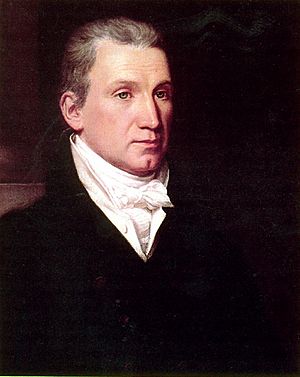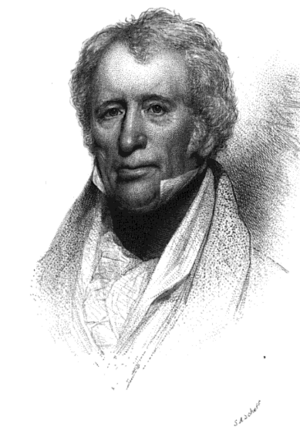Era of Good Feelings facts for kids
| 1817–1825 | |

Independence Day Celebration in Centre Square by John Lewis Krimmel, 1819
|
|
| Preceded by | Jeffersonian era |
|---|---|
| Followed by | Jacksonian era |
The Era of Good Feelings was a time in American history when people felt a strong sense of national pride and wanted to work together. This happened after the War of 1812. During this period, the Federalist Party became very weak and almost disappeared. This meant there were fewer big arguments between political groups.
President James Monroe was in charge during most of this era (1817–1825). He really wanted to bring the country together. He hoped to get rid of political parties completely. Because of his efforts, his time as president is often called the Era of Good Feelings.
However, some historians say the name "Era of Good Feelings" is a bit ironic. Even though there was a desire for unity, there were still many disagreements. These often happened within Monroe's own government and the main political party, the Democratic-Republican Party. After the 1824 presidential election, the Democratic-Republican Party split into new groups. This led to the start of the Second Party System in American politics.
The phrase "Era of Good Feelings" was first used by a journalist named Benjamin Russell. He wrote it in a Boston newspaper in 1817. This was after President Monroe visited Boston during a tour to promote unity.
Contents
A United Nation After War
The Era of Good Feelings began around 1815, right after the War of 1812 ended. People felt very proud of their country. The strong disagreements between different parts of the United States started to calm down. For example, the arguments between the North and South, and between cities and frontier settlers, became less intense.
A big reason for this was that the Federalist Party had mostly fallen apart. This happened after a meeting called the Hartford Convention in 1814–15. The Federalists lost much of their power across the country. The Democratic-Republican Party was the main party left. But even they weren't very active at the national level.
During this time, there was a growing idea that the federal government should play a bigger role. It was thought that the government should help the country grow and become rich. President James Madison, who was Monroe's predecessor, learned from the War of 1812. He saw that some Federalist ideas were actually helpful. He supported plans like creating a national bank and a protective tariff. These ideas were part of something called the American System, proposed by John C. Calhoun and Henry Clay.
Madison believed that the country was ready for these changes. He felt that the states would agree to them. This new way of thinking, called "new Republicanism," helped set the stage for Monroe's "Era of Good Feelings." It brought a feeling of hope and a desire for political peace. Monroe won the 1816 presidential election easily against the Federalist Rufus King. This showed that people were ready for a more unified country.
President Monroe and Political Parties
When James Monroe became president, many people hoped he would bring political parties together. They wanted him to help the country focus on shared goals, not just party interests. Some even suggested he include a Federalist in his cabinet. This would show that the nation was truly united.
However, Monroe believed the Federalist Party wanted to bring back a king and end the republic. He thought that if he appointed a Federalist, it would only keep their party alive. He did not want his government to be influenced by Federalist ideas.
Monroe's main goal was to get rid of all political parties, including his own Republican party. He felt that political parties were bad for a free government. To weaken the Federalists, he simply ignored them. Federalists were not given government jobs or support. Monroe wanted to remove Federalists from power in both federal and state governments, especially in New England. He believed that any sign of approval would give them hope for a comeback, which he wanted to avoid.
Some historians think Monroe did reduce party politics. One big sign of this was his re-election in the 1820 presidential election. He ran almost completely unopposed. The Federalists didn't even put forward a candidate to run against him for president. Monroe and his vice president, Daniel D. Tompkins, nearly won every single vote in the electoral college. Only a few electors voted for other candidates. This election remains the last time a presidential candidate ran without a major opponent.
Monroe's Goodwill Tour and National Unity
A great example of the Era of Good Feelings was President Monroe's tour across the country in 1817 and 1819. His visits to New England, especially Boston, Massachusetts, were very important. It was in Boston that the phrase "Era of Good Feelings" was first used by a local Federalist newspaper.
Monroe's appearance and personality helped create good feelings during the tour. He wore an old-fashioned Revolutionary War officer's uniform. He also tied his long, powdered hair in a queue, a style from the 1700s. People described him as "tall, rawboned, venerable" and found him charming. He made a good impression and was able to make people feel comfortable.
When Monroe visited Boston, there was a huge show of national pride and a desire for unity. Federalists in New England were especially eager to show their loyalty. This was after the difficult Hartford Convention. During the celebrations, many people openly declared their desire to rejoin "the great family of the union." Even Abigail Adams called it a "cleansing."
In Boston, the heart of Federalist territory, Monroe achieved a key goal of his tour. He allowed the Federalists to publicly show their loyalty to the government. They also showed their acceptance of Republican leadership. Monroe was careful not to say anything that would embarrass his hosts. He acted simply as the head of the country, not as the leader of a winning political party.
In the years that followed, most New England states came under Republican control. By 1820, the Federalist Party had almost completely disappeared. Even though it seemed like a good time to appoint former Federalists to government jobs, Monroe was still worried. He feared a negative reaction. He was also concerned about growing tensions over the upcoming 1824 presidential election. This election would be a fight between members of his own party. Because of these worries, Monroe never fully brought the Federalists back into the government.
Challenges to Unity and New Divisions
President Monroe's efforts to reduce political arguments made it seem like everyone in America was united. Almost everyone called themselves a Republican. His nearly unanimous re-election in 1820 seemed to prove this unity.
Monroe knew that rivalries could still happen within his own party. So, he tried to include future presidential candidates and important leaders in his government. His cabinet included three rivals who would run for president in 1824: John Quincy Adams, John C. Calhoun, and William H. Crawford. Another important figure, Andrew Jackson, held high military positions. Monroe hoped to manage their disagreements and find compromises within his administration. However, this approach meant he couldn't rely on party unity to pass his plans in Congress.
When Monroe decided to be a leader for the whole nation, not just his party, he lost some party control. People no longer strictly followed the old ideas of Thomas Jefferson. These ideas included states having more power, interpreting the Constitution strictly, and protecting Southern ways of life. Some older Republicans, like John Randolph of Roanoke, warned that moving away from Jefferson's ideas would cause problems. They feared it would lead to conflict between the North and South, threatening the country's unity. Even former president James Madison had told Monroe that political parties would naturally form in any free government.
Two major events showed that the "good feelings" were fading. The first was the Panic of 1819, a serious economic downturn. The second was a Supreme Court case called McCulloch v. Maryland. Both brought back old arguments about whether states or the federal government had more power. They also renewed debates about how strictly the US Constitution should be interpreted.
Then came the Missouri Crisis in 1820. This event clearly showed the explosive conflict between states that allowed slavery and those that did not. Only through the clever work of House Speaker Henry Clay was a solution found. This avoided a split in the country for a while.
As political agreement declined, it became important to bring back Jefferson's ideas, especially those related to the South. A new alliance between farmers in the North and South would form. This led to the rise of Jacksonian Nationalism and the modern Democratic Party. The short period known as the Era of Good Feelings had come to an end.
Images for kids




